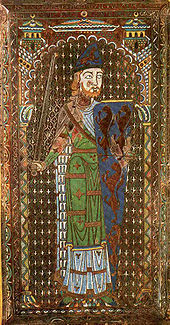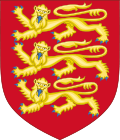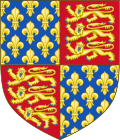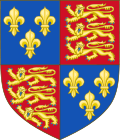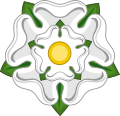- Armorial of Plantagenet
-
This is a list of the coats of arms known or believed to be borne by Geoffrey Plantagenet, Count of Anjou, and his descendants in the male line.
Contents
Family chief
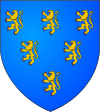
Geoffrey V (1113 † 1151), Count of Anjou Azure, six lions rampant or[1]
That Geoffrey used this coat is inferred from his memorial enamel, which shows four lions on half of his shield, arranged in a manner to suggest that this was the same as the six-lion shield borne by his grandson William Longespée, 3rd Earl of Salisbury (c. 1176 † 1226; illegitimate son of Geoffrey's son Henry II of England) and by William's son William II Longespée (c. 1212 † 1250).[2]
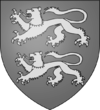

Henry II (1133 † 1189), son of previous, king of England, duke of Normandy, count of Anjou. No coat is directly attested for him, but it has been deduced from the bearings of his immediate family that he bore a coat with two lions passant, with the tinctures unknown. - John Lackland (1166 † 1216; later King John) as Lord of Ireland and Count of Mortain also used such a coat[3]
By later tradition, Henry II is said to have used the arms that later came to designate the Duchy of Normandy:
gules, two lions passant guardant in pale or[1]
This coat was used by:
- Richard FitzRoy, (c. 1190 † 1246), baron of Chilham, illegitimate son of king John.[2]
In French blazoning, the lion passant guardant was often termed a léopard. However, this usage was never widespread in England, and is long obsolete.[4]
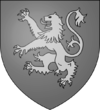
or perhaps
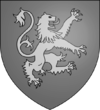
or

 Arms as they appear on 1st Great Seal of Richard I
Arms as they appear on 1st Great Seal of Richard I
 Arms as they appear on 2nd Great Seal of Richard I
Arms as they appear on 2nd Great Seal of Richard I
Richard I the Lionheart (1157 † 1199), son of previous, king of England, duke of Normandy and Aquitaine, count of Anjou and Poitiers
His arms are only known from two armorial seals, and hence the tinctures can not be determined. His First Great Seal showed one lion on half of the shield. It is debated whether this was meant to represent two lions combattant or a single lion, and if the latter, whether the direction in which the lion is facing is relevant or simply an artistic liberty. A simple lion rampant is most likely.[5]
At the end of his life, his second seal showed three lions, clearly the three-lion coat used by his successors.[5][1] [1]
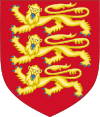
Kings of England and dukes of Aquitaine from 1198 to 1340 : - Richard I the Lionheart (1157 † 1199)
- John Lackland (1166 † 1216)
- Henry III (1207 † 1272)
- Edward I Longshanks (1237 † 1307)
- Edward II (1284 † 1327)
- Edward III (1312 † 1377)
gules, three lions passant guardant in pale or.[1]

Kings of England and dukes of Aquitaine from 1340 to 1400 : - Edward III (1312 † 1377)
- Richard II (1367 † 1399), who impaled his coats of arms with Edward the Confessor's mythical blazon[1] (see below)
- Henry IV (1367 † 1413)
In 1340, Edward III claimed the throne of France as an inheritance from his mother, Isabella, da. of King Philip IV of France, and adopted new arms, Quarterly France and England.[1] Such arms are termed "Arms of Pretension", where a sovereign adopts arms illustrative of a claim de jure (by right) to the throne of another kingdom.[6]
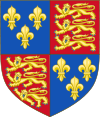
Kings of England from 1400 to 1603 : - Henry IV (1367 † 1413)
- Henry V (1387 † 1422)
- Henry VI (1421 † 1471)
- Edward IV (1442 † 1483)
- Edward V (1470 † 1483)
- Richard III (1452 † 1485)
In 1376, the kings of France altered the royal coat of arms, replacing the field semé-de-lis with three fleurs-de-lis, alluding to the Trinity. This new design is referred to as France Moderne, the previous one being France Ancien.[7] From about 1400 the kings of England imitated this change. As modified, the monarchs of England continued to bear arms in this form until the crown union with Scotland in 1603.[1]
Heirs
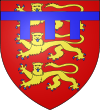
Edward of Caernarvon (1284 † 1327), Prince of Wales, later King Edward II England with a label of three points azure.
This blazon was probably borne by his son Edward (later King Edward III) as Prince of Wales.[8]

Edward of Woodstock (1330 † 1376), the Black Prince, Prince of Wales, son of Edward III Quarterly France and England, over all a label of three points argent..[8]
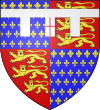
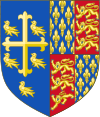
Richard of Bordeaux (1367 † 1399), son of the Black Prince, later Prince of Wales and later King of England (Richard II). During his father's lifetime he added a cross of Saint George to the middle point of the label.
As king, he combined the royal arms with the mythical coat attributed to Edward the Confessor: Per pale, 1st azure a cross flory between five martlets, all or; 2nd quarterly France and England.

Princes of Wales from 1405 to 1547 : - Henry of Monmouth (1387 † 1422), later Henry V, son of Henry IV
- Edward of Westminster (1453 † 1472), son of Henry VI
- Edward (1470 † 1483), later Edward V, son of Edward IV
- Edward of Middleham (1473 † 1485), son of Richard III,
- Prince of Wales of House of Tudor.
Quarterly France and England, over all a label argent.
cadets

William FitzEmpress (1136 † 1163/4), viscount of Dieppe, then Count of Poitou, son of Geoffrey V, Count of Anjou, used an arms with a single lion, tinctures unknown.[9] William Longespée (c.1176 † 1226), earl of Salisbury, illegitimate son of Henry II, king of England first used a single lion, tincture unknown, before adopting the six-lion coat of his paternal grandfather, Geoffrey V, Count of Anjou.[2]


Richard (1209 † 1272), earl of Cornwall, then king of the Romans, son of John Lackland, king of England Argent, a lion rampant gules crowned or a bordure sable bezantée.
Arms of the counts of Poitiers (see Richard Lionheart above), with a brisure.[10]
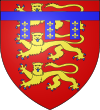
Earls of Lancaster issued from Edmund Crouchback England with a label azure semé-de-lis or..[11]
- Edmund Crouchback, 1st Earl of Lancaster (1246 † 1296)
- Thomas, 2nd Earl of Lancaster (1280 † 1322), forfeit 1322
- Henry, 3rd Earl of Lancaster (1281 † 1345), restored 1327
- Henry of Grosmont, Duke of Lancaster (1300 † 1361)
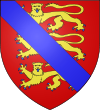
Henry (1281 † 1345), earl of Leicester, son of Edmund Crouchback, 1st Earl of Lancaster, before restoration as Earl of Lancaster in 1327 England with a bendlet azure.[8]

Thomas of Brotherton (1300 † 1338), Earl of Norfolk, son of Edward I Longshanks. England with a label of three points argent.[8]
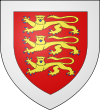
Edmund of Woodstock (1301 † 1330), Earl of Kent, son of Edward I. England with a bordure argent.[8]
His daughter Joan of Kent and her descendants the Holland earls of Kent bore these arms.
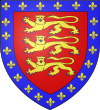
John of Eltham (1316 † 1336), Earl of Cornwall, son of Edward II England with a bordure azure charged with fleurs-de-lis or.[11]
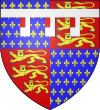
Lionel of Antwerp (1338 † 1368), 1st Duke of Clarence, second son of Edward III. Quarterly France and England, over all a label of five points, each point bearing a cross gules.
There is also evidence that he sometimes carried, as pictured,
Quarterly France and England, over all a label of three points, each point bearing a canton gules.[8]
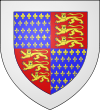
Thomas of Woodstock (1355 † 1397), earl of Essex, of Buckingham and duke of Gloucester, fifth son of Edward III Quarterly France and England, over all a bordure argent.[11]
House of Lancaster

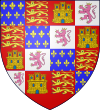
John of Gaunt (1340 † 1399), Duke of Lancaster, third son of Edward III.[8] In 1371, he married Constance of Castile, heiress of Pedro the Cruel, king of Castile and Leon. Claiming the throne of Castile and Leon, he quartered the arms of France-England with those of Castile-Leon.
Quarterly, 1st and 4th quarterly France and England, 2nd and 3rd quarterly Castile and Leon.
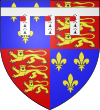
Thomas of Lancaster (1388 † 1421), Duke of Clarence, son of Henry IV. Quarterly France and England, over all a label of three points ermine, on each point a canton gules.

John of Lancaster (1389 † 1435), Duke of Bedford, son of Henry IV. 
Humphrey of Lancaster (1389 † 1447), Duke of Gloucester, son of Henry IV.[11] Quarterly France and England, over all a bordure argent.

Earls and dukes of Somerset issued from John Beaufort (1371 † 1410), son of John of Gaunt[8]: - John Beaufort, 1st Earl of Somerset (1371 † 1410)
- Henry Beaufort, 2nd Earl of Somerset (1401 † 1418)
- John Beaufort, 3rd Earl of Somerset (1404 † 1444) (became Duke of Somerset in 1443)
- Edmund Beaufort, 4th Earl of Somerset (1406 † 1455) (became Duke of Somerset in 1448)
- Henry Beaufort, 2nd (or 3rd) Duke of Somerset (1436 † 1464)
- Edmund Beaufort, 3rd (or 4th) Duke of Somerset (c. 1439 † 1471)
Quarterly France and England, over all a bordure compony argent and azure.
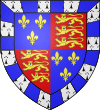
Thomas Beaufort (1377 † 1426), Duke of Exeter, son of John of Gaunt Quarterly France and England, over all a bordure compony ermine and azure.
House of York
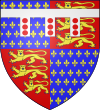

Dukes of York issued from Edmund of Langley, fourth son of Edward III.[8] His son Edward of Norwich followed the king in reducing the fleurs-de-lis to three.
- Edmund of Langley, 1st Duke of York (1341 † 1402).
- Edward of Norwich, 2nd Duke of York (c. 1373 † 1415) — Son of Edmund of Langley.
- Richard Plantagenet, 3rd Duke of York (1411 † 1460) — Nephew of Edward of Norwich.
- Edward Plantagenet, 4th Duke of York (1442 † 1483) — Son of Richard Plantagenet. Became King Edward IV in 1461.
Quarterly France and England, with a label of three points argent, each point charged with three torteaux.

Richard of Conisburgh (1376 † 1415), 3rd Earl of Cambridge, son of Edmund of Langley. Quarterly France and England, with a label of three points argent, each point charged with three torteaux, a bordure argent charged with lions rampant gules.
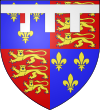
Richard of Shrewsbury (1473 † 1483), Duke of York, second son of Edward IV. Quarterly France and England, a label of three points argent, on the first point a canton gules.
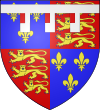
George (1449 † 1478), Duke of Clarence, brother of Edward IV.[8] Quarterly France and England, a label of three points argent, on each point a canton gules.
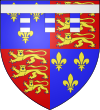
Edward (1475 † 1499), Earl of Warwick, son of George, Duke of Clarence. Quarterly France and England, a label of three points barry argent and azure.

Richard (1452 † 1485), duke of Gloucester, brother of Edward IV, later Richard III. Quarterly France and England, a label of three points ermine.
See also
Royal coat of arms of the United Kingdom
References
- ^ a b c d e f g Brooke-Little, J.P., FSA (1978) [1950]. Boutell's Heraldry (Revised Edition ed.). London: Frederick Warne LTD. pp. 205–222. ISBN 0-7232-2096-4.
- ^ a b c Ailes, Adrian (1982). The Origins of The Royal Arms of England. Reading: Graduate Center for Medieval Studies, University of Reading. pp. 52–53.
- ^ Ailes. pp. 52–63.
- ^ Fox-Davies, Arthur [1909] (1978). Complete Guide to Heraldry, A, New York: Bonanza Books, pp.173
- ^ a b Ailes. pp. 52–3, 64–74.
- ^ Encyclopedia Brittannica, 9th ed. vol.11, Heraldry, p.689
- ^ fr:Armoiries de la France
- ^ a b c d e f g h i j Brooke-Little, J.P., FSA (1978) [1950]. Boutell's Heraldry (Revised Edition ed.). London: Frederick Warne LTD. pp. 118–121. ISBN 0-7232-2096-4.
- ^ Ailes. pp. 52–3,55.
- ^ Boutell, Charles (1914). Fox-Davies, A.C.. ed. Handbook to English Heraldry, The (11th Edition ed.). London: Reeves & Turner. pp. 94–95.
- ^ a b c d Boutell, Charles (1914). Fox-Davies, A.C.. ed. Handbook to English Heraldry, The (11th Edition ed.). London: Reeves & Turner. pp. 176–193.
Categories:- House of Plantagenet
- Lists of British coats of arms
- Lists of coats of arms
Wikimedia Foundation. 2010.

